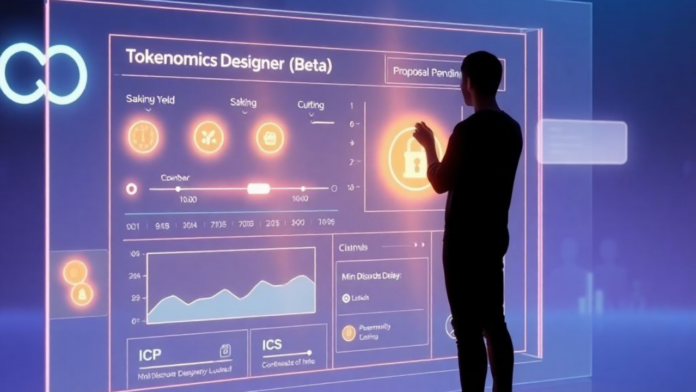The latest entrant to the Internet Computer’s DeFi ecosystem has arrived, and it’s stepping into the ring with purpose — not punches. Neutrinite DAO has officially launched the beta version of its Tokenomics Designer, which developers claim is the most advanced system of its kind on the Internet Computer. And if their liquid staking protocol is anything to go by, they’re just getting started.
Anvil, one of the DAO’s core developers, announced the beta launch on X, adding that the liquid staking protocol is built and ready. The only thing holding back deployment is the adoption of a few proposed upgrades to the Internet Computer’s base tokenomics. Once those tweaks are through, Neutrinite plans to hit the switch.
The message from Neutrinite’s side is straightforward: there’s no race, no arms-length rivalries, and no desire to chip away at others’ projects. Instead, they’re painting their protocol as one that plays well with others. Anvil’s response to a sceptical user’s accusation of launching a competitor with a shadowy backstory was clear and measured. “There is no such competition,” he wrote. “It’s not about me taking from you or you taking from me. We will be doomed if so. It’s about making a fair protocol that is worthy of becoming internationally adopted W3C like standard.”
The proposed upgrades to Internet Computer’s tokenomics are modest yet meaningful. Neutrinite suggests holding the line on minimum dissolve delay — a key part of staking mechanics that ensures long-term commitment — and plugging a few reward leaks that have crept into the system. These aren’t radical changes. They’re more about reinforcing what’s already there and cleaning up inefficiencies. For a project like Neutrinite that’s based around liquidity and fairness, those refinements are essential.
The Tokenomics Designer itself is designed to simplify the complex. It’s intended to be a visual, customisable system for building, simulating, and fine-tuning decentralised financial models. If that sounds ambitious, it is. But it’s also the kind of tooling that’s been largely missing in the Internet Computer space, where most DeFi projects still rely on spreadsheets, custom code, and hand-tuned models.
By putting powerful token design tools in the hands of developers and communities, Neutrinite is betting on collaboration and creativity to win the day. It’s a way to lower the technical barriers to entry for anyone trying to build sustainable decentralised economies. That kind of access could prove game-changing.
The launch hasn’t been without drama. The now-deleted exchange between X user @ICPfinder and Anvil brought up a running tension that’s been bubbling in corners of the Internet Computer community. The claim was blunt: that this was a covert project spun out from another, and that Anvil and another developer named Adam were secretly behind both.
The reply was more philosophical than defensive. Anvil brushed aside the idea of internal sabotage, framing the whole project as part of a shared mission. It wasn’t a denial of involvement; it was a reframing of the stakes. “We will be doomed if so,” he warned, pointing to the dangers of infighting in a space that’s still trying to find its feet.
What makes the back-and-forth stand out is its tone. There’s a certain weariness in Anvil’s response, as if the usual crypto drama was expected — but not welcome. The project’s roadmap doesn’t seem to hinge on hype or spectacle. Instead, it’s anchored to technical milestones and slow, deliberate progress.
The beta itself is now open, and community members can poke around the Tokenomics Designer and get a feel for what it can do. While it’s not yet tied into the active staking system, that’s coming soon — assuming the wider Internet Computer ecosystem greenlights the proposed changes. Until then, Neutrinite appears content to keep refining its tools and proving their worth in public view.
What makes this especially interesting is the timing. DeFi on the Internet Computer has been building slowly, with most of the early growth driven by trading platforms and NFT marketplaces. Complex, protocol-level financial design has been more of a wishlist item than a present-day reality. Neutrinite is trying to change that by bringing the kind of tooling that makes proper token economies feasible.
There’s a broader play here too. By aligning their system with web standards bodies like W3C, Neutrinite is sending a message about interoperability and staying power. If the system can mature into something reliable enough to be considered a standard — the kind that other chains, projects, and institutions might adopt — that’s a very different kind of success.
There’s always a temptation to frame these launches as showdowns. A new project arrives, lines are drawn, and sides are chosen. Neutrinite’s developers are clearly resisting that impulse. Instead of a turf war, they’re positioning their launch as a technical contribution to a shared ecosystem. Whether or not the community accepts that framing remains to be seen.
There’s also the question of speed. The project is ready, but its deployment is contingent on changes to the Internet Computer’s core mechanics — changes that require proposal submissions, votes, and a fair bit of patience. That’s a gamble. The longer the delay, the more time there is for competitor projects to emerge or existing ones to evolve. But from the way Anvil speaks about it, that risk seems acceptable if the outcome is a fairer, more robust foundation.
One of the big promises of Neutrinite’s liquid staking protocol is how it approaches decentralised participation. With traditional staking, there are often trade-offs between security, flexibility, and reward predictability. Neutrinite’s protocol claims to optimise for all three by using adaptive models that respond to on-chain behaviour and macro token supply signals. That level of responsiveness could set it apart if it delivers in practice.
The DAO structure backing Neutrinite is also worth watching. Unlike some governance models that concentrate voting power among early contributors or whales, Neutrinite is pledging to keep participation broad and transparent. Whether or not that holds once real capital is involved will be the real test.
What’s certain for now is that the beta launch isn’t just for show. There’s working code, a clear vision, and a path forward — albeit one that’s dependent on broader consensus. The tools are live, the protocol is ready, and the debate around tokenomics tweaks is out in the open.
All of this makes Neutrinite a bit of a curiosity within the Internet Computer landscape. It’s technical but accessible, ambitious without being brash, and emerging from a backdrop of occasional community drama with a calm voice and a tidy product.
Whether it ends up as a cornerstone of DeFi on the Internet Computer or just a thoughtful footnote depends on what happens next. The conversation has started. The proposals are in motion. And a beta’s already humming.
The timing might be uncertain, but the intention couldn’t be clearer. Neutrinite wants to build something worth keeping, and they’re doing it out loud. That alone is worth paying attention to.


